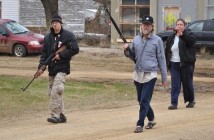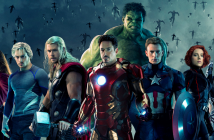The Bride of Frankenstein (1935)
Cast: Boris Karloff, Elsa Lanchester, Colin Clive
Director: James Whale
Country: USA
Genre: Horror | Sci-Fi
Official Site: Here
Editor’s Notes: The following review is part of our coverage for TIFF’s Second Coming: Cinema’s Greatest Sequels. For more information on upcoming TIFF film series visit http://tiff.net and follow TIFF on Twitter at @TIFF_NET.
More beautiful in death than in life, the stripes of her electric beehive set off by the stark white of her medical gown, a creature known only as The Bride (Elsa Lanchester) takes her first steps in the laboratory of Dr. Henry Frankenstein (Colin Clive). She is not his first ungodly creation but rather the intended mate of her predecessor, both corpses brought back to life by shocks of lightning. This resurrection scene in The Bride of Frankenstein (1935) is a true spectacle, the cavernous laboratory and its impressive (if vague) scientific equipment channeling an electrical storm more frightening than the one that reanimated The Monster (Boris Karloff) in Frankenstein (1931), the creature who now desires a woman to call his own.
Frankenstein, based on Mary Shelley’s Gothic hair-raiser Frankenstein; or, The Modern Prometheus, was the first film of what would become a series featuring the undead Monster. It was the fourth movie for James Whale, and under his direction and actor Boris Karloff’s superlative performance as The Monster, Frankenstein became one of the biggest hits of 1931 and an unquestioned horror classic.
Dispensing with nearly all the solemnity of the original, Whale concocted in The Bride of Frankenstein a comedy-horror amalgam, a Gothic, art deco satire so broad that it frequently threatened to come apart at the seams and turn into full-blooded farce.
Its sequel, The Bride of Frankenstein, also directed by James Whale, picks up almost where the original left off and concerns Dr. Frankenstein’s attempt to create a female version of his reanimated corpse as a companion for The Monster. Whale’s Frankenstein was a marvel of subtly, relatively speaking, considering its lofty philosophical concerns were posed by an emotionally tormented scientist and the seven-foot-tall green-faced zombie he’d just stitched together with catgut and lightning. Dispensing with nearly all the solemnity of the original, Whale concocted in The Bride of Frankenstein a comedy-horror amalgam, a Gothic, art deco satire so broad that it frequently threatened to come apart at the seams and turn into full-blooded farce.
This was surely in part due to the restrictions of the Motion Picture Production Code; a veneer of humor always helped edgier adult themes get past the censors. It also reflected the much stickier situation regarding the creation of The Bride as compared to the creation of The Monster. While The Monster had been pieced together from the body parts of executed male criminals, The Bride necessarily had a more delicate pedigree, something sure to make many in the audience squeamish. The idea that men’s bodies were stolen, dissected and reassembled was frightening enough; the same idea applied to women’s bodies was heresy.
This was not surprising considering nearly two centuries of grave robbing in both news and legend, including the infamous Doctors’ Riot of New York City in the spring of 1788. Relatives of the recently deceased had been pleading with local officials to do something about medical students stealing corpses from local cemeteries, but to no avail. Body snatchings in the 18th Century were, according to historian Stephen R. Prothero, “an almost daily occurrence,” and sensationalist magazines of the day would relate stories of men “outraging the fresh corpses of young and pretty women;” it’s hardly any wonder an angry mob stormed a medical school where hundreds of anatomical specimens were held. Bess Lovejoy’s “Body Snatchers of Old New York” quotes a witness to the Doctor’s Riot, one Colonel William Heth:
“In the Anatomy room, were found three fresh bodies — one, boiling in a kettle, and two others cutting up — with certain parts of the two sex’s hanging up in a most brutal position.”
Soon, there were laws forbidding the unauthorized removal of corpses from their graves in many jurisdictions, and medical students came to rely on the bodies of executed prisoners for their experiments. This meant almost no corpses available for medical study were female.
Interestingly, the cultural and artistic response to the dead female body changed around this time as well. Take for example Rembrandt’s The Anatomy Lesson of Dr. Nicolaes Tulp (1632). The surgeons portrayed are looking forward toward the viewer, as in portraiture, and the corpse about to be dissected is a male criminal, mostly clothed. A century later, an unknown artist would create a birch and ivory model based heavily on Rembrandt’s scene, but replacing the male with a young woman, her naked body beautiful and serene, delicately opened to reveal heart and lungs, the doctors looking at her as an object of desire. Death was largely synonymous with sexuality in the 18th century, and a female body on display, even for anatomical and medical reasons, took on the traits of a work of art.
Whale lampooned himself in Bride of Frankenstein as much as he lampooned the entire horror genre. He also indulged in a heap of subversion, not only with the copious Christian imagery and the theme of man tampering in God’s domain, but in his radical take on the family unit.
Art, however, was hardly on Whale’s mind when he agreed to a sequel to Frankenstein. Whale lampooned himself in Bride of Frankenstein as much as he lampooned the entire horror genre. He also indulged in a heap of subversion, not only with the copious Christian imagery and the theme of man tampering in God’s domain, but in his radical take on the family unit.
In the pre-Code era, characters were often coded as gay while not explicitly described as such. In The Bride, Whale hardly bothers coding the characters at all. Gavin Gordon’s portrayal of Lord Byron in the sly opening scene is all limp wrists and prancing, and once the tale of The Bride gets underway, the sinister Dr. Pretorius — a deliciously over-the-top Ernest Thesiger — could hardly be seen as anything but gay. He’s a sniffy stereotype who dislikes women and is described as “a queer one,” and his quest to convince Dr. Frankenstein to return to the business of playing God unmistakably plays as homosexual seduction and blackmail
In turn, the film sees heterosexual pairing and family units as disposable. Two male-female couples meet gruesome ends, while the main couple — Henry and Elizabeth (Valerie Hobson), the other bride of Frankenstein — are kept apart throughout much of the film. Male-male couples form far more easily, not just in the case of Henry and Dr. Pretorius, but The Monster and a blind hermit in the woods, his first real friend, one the hermit cheekily thanks God himself for providing.
There are, however, two primary obstacles in these male-male couplings, at least according to Bride of Frankenstein: society’s response and the inability to procreate. Little is done about the former, as The Monster’s outsider status is used as a source of pathos and impetus to create The Bride. As to the latter, Pretorius makes it clear that procreation without women is his ultimate goal. His homunculi — miniature humans kept in jars, the portrayal of which was a great technological feat for the time — were grown “as nature does, from seed.” As he tries to convince Frankenstein to join him, he works on the troubled doctor’s desires: “you and I, together…we follow the lead of nature.
It’s only in the last few minutes of the film that we even see their creation, The Bride, her appearance even more anticipated than The Monster’s had been in the first film. Beautiful and grotesque, her bandages and surgical robe forming an ersatz wedding gown, the men in the laboratory who have put all their hopes into her creation learn in a moment of comedic justice that even dead women have this pesky thing known as free will. All that trouble they’ve gone to, Drs. Frankenstein and Pretorius, all that hard work and scheming and science, and the dame goes and ruins it by shunning the advances of the man-creature she was made for.
Though a bit creaky in that early-1930s way and occasionally stagey, The Bride of Frankenstein is as entertaining today as it must have been on release. Iconic and frightening and whole lot of fun, The Bride of Frankenstein is not only a worthy successor to Frankenstein, but a rare case where the sequel may just outpace the original.
Though a bit creaky in that early-1930s way and occasionally stagey, The Bride of Frankenstein is as entertaining today as it must have been on release. Iconic and frightening and whole lot of fun, The Bride of Frankenstein is not only a worthy successor to Frankenstein, but a rare case where the sequel may just outpace the original.




